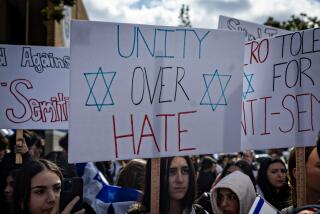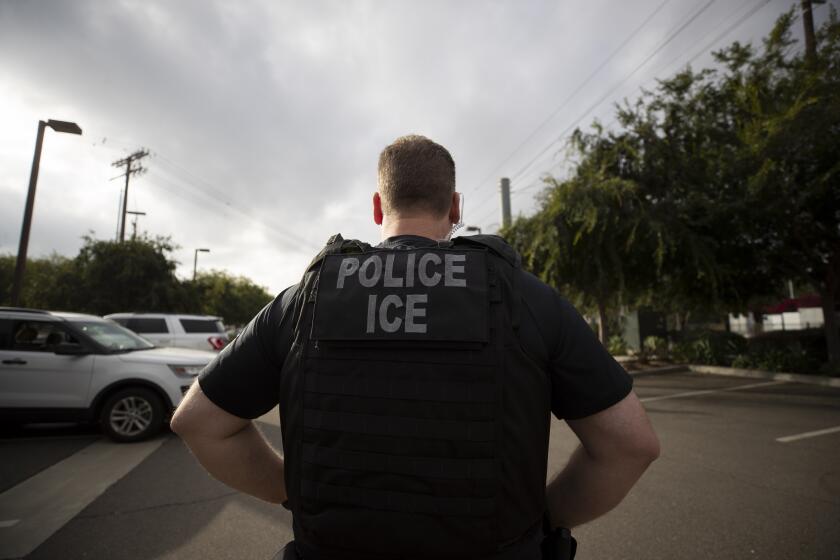150,000 Are in Gangs, Report by D.A. Claims : Crime: Reiner’s study says half of young blacks are members. But even Gates says numbers may be too high.
- Share via
As Los Angeles County battles the worst epidemic of gang violence in its history, an unprecedented report says that Latino gang activity is up, black gang activity is down and--in what may be the most staggering and explosive finding of all--nearly half of all young black men in the county have been identified as gang members by police.
The wide-ranging study, made public Thursday by Los Angeles County Dist. Atty. Ira Reiner and billed as the most thorough examination ever of the county’s gang problem, paints a troubling sociological portrait of a region it says has an estimated 1,000 gangs and 150,000 gang members.
But as news of the report filtered into the community, gang workers, civil liberties advocates and inner-city residents lashed out at the numbers, saying they confirm what police critics already know: That authorities stereotype--and single out for arrest--young black men simply by the clothing they wear and the neighborhoods they live in.
The report, prepared by the district attorney’s staff, was peppered with surprising conclusions: Gang members are almost entirely responsible for the dramatic upswing in the county’s murder rate since 1984; innocent bystanders may account for as few as 10% of the victims of gang crimes; and although drugs and gangs are intertwined, “most gang members are not drug dealers in any meaningful sense of the word.”
By far the most disturbing and controversial revelation comes in the report’s examination of gangs in the black community. It found that 47% of black men between 21 and 24 show up in police gang databases. Yet only 8.5% of all Latinos in that age group show up in the databases. Among young Anglo men, the figure is less than one-half of one percent.
Even Los Angeles Police Chief Daryl F. Gates acknowledged that the numbers may inadvertently include some non-gang members. And Reiner himself said the figures are so disturbing that they cannot be accepted at face value.
“That number may be artificially high,” the district attorney said. “But on the other hand it may not be. . . . It may mean just what it says, that about one out of every two young black males are involved in gangs.”
Others were far more pointed in the comments. “We deeply deplore and stand against the characterizations that have been made against black men,” said an angry Rev. Edgar E. Boyd, pastor of the Bethel African Methodist Episcopal Church in South Los Angeles. “I stand very much outraged.”
Entitled “Gangs, Crime and Violence in Los Angeles,” the 235-page document is in many ways a wake-up call for reform. Through recommendations for improved education, job training and gang prevention programs, it attempts to chart a course for turning the gang tide--a task that Reiner said will take “at least a generation.”
The efforts, the study says, must begin immediately: “With gang homicides already approaching 800 a year, the cost of delay must be calculated in blood.”
Some of the study’s findings contradict widely held beliefs about gangs:
* While the Los Angeles County murder rate is on the upswing, it is not because society as a whole is more violent. Rather, gangs are responsible for the increase. Since 1984, annual gang-related homicides more than tripled, from 212 to 771 last year. But non-gang-related murders remained nearly the same, rising from 1,230 in 1984 to 1,276 in 1990.
* Gang youths are four times as likely to sell drugs as those not involved in gangs, and when gang members are asked whether they have sold drugs in the last year, roughly half say yes. Nonetheless, the report says, “There is little evidence that the traditional turf gangs in Los Angeles have begun to change their focus and operate primarily as drug distribution networks.”
* Despite the media attention given to innocent bystanders gunned down by gang members, law-abiding citizens may account for as few as 10% of all victims of gang crimes. “Even though gang marksmanship is notoriously bad, and increasingly indiscriminate,” the study says, “gang shooters still hit their targets more often than they hit bystanders.”
* Some gang researchers believe that crackdowns such as the LAPD’s Operation Hammer may have the unintended effect of strengthening gangs by unifying them in opposition to police.
* Latino gang violence is reported to be up dramatically--the Sheriff’s Department logged a 96% increase in Latino gang murders in 1990 from the previous year. The report attributed this to an influx of Central American immigrants, whose new gangs are renewing turf fights already settled by older Mexican-American gangs.
* While law enforcement authorities generally believe that Asian gang violence is on the rise, there is no statistical evidence to support that contention.
* Although the days of the rumble went out with the movie “West Side Story,” the essential gang ethic that requires members to prove their honor and defend their neighborhood remains unchanged. “Contrary to popular belief,” the report says, “most gang homicides are not random shootings, nor are they disputes over drugs or some other crime. Gang homicides are the product of old-fashioned gang fights over turf, status and revenge.”
In the section on gangs and the black community, the study cites LAPD statistics showing a sharp decrease in killings attributed to black gangs. In 1990, black gangs were blamed for 32% of all gang murders, compared to 51% in 1988.
As to why young black men appear so frequently in police databases, the study offered several possible explanations: Black youths are more likely to be arrested than other youths, crime may be a more viable career alternative for black youths, and high numbers of black youths may be failing to leave gangs at the traditional time--in their early 20s.
The statistics in the report are derived primarily from a database maintained by the Sheriff’s Department, supplemented by information from the LAPD. The names in the database are culled from arrest reports, interviews, probation reports and so-called “field inquiry cards” filled in by law enforcement officers who stop youths on the street.
Reiner called the statistics “frankly very disturbing,” and said that both the Sheriff’s Department and the LAPD ought to review their procedures to see if blacks are being unfairly targeted.
Meanwhile, civil liberties advocates, academicians, inner-city residents--and even Gates--voiced some skepticism about the numbers.
“It’s absolute bunk,” Carol Watson, a prominent civil rights attorney, said of the police figures. “They stop young men of color . . . and if they happen to be wearing an article of clothing that could possibly be construed as somebody’s gang, they will call them gang members.”
Said 17-year-old Tyrell Picket of South Los Angeles: “Police see a group of young blacks and they think we are a gang. We get labeled.”
Even gang expert Malcolm Klein, a USC professor whose work is quoted widely in the report, said he was “truly surprised” by the figures. “If it is correct,” he said, “it represents a far greater problem than has been acknowledged until now.”
Gates conceded that authorities may unfairly classify as gang members some young people, such as those who flash gang signs but are not really gang members. “I suppose a lot of people out there are showing gang signs and things like that because they are scared to death of gangs, and we tend to classify them as being in a gang,” Gates said.
In addition to law enforcement statistics, the study draws on sociological studies and interviews with prosecutors, police, academics, gang counselors and gang members. It offers numerous recommendations for change.
Los Angeles County, the study complains, has no master plan for helping young people at risk of joining gangs.
More gang prevention programs are desperately needed, the report says, as is an overhaul of the juvenile justice system. And the study says police and prosecutors must focus more heavily on the 10% to 15% of gang members who are considered “hard-core” criminals beyond redemption.
The most important anti-gang strategy the county can take, according to the report, is to improve its public schools. Just as necessary, it says, is persuading private industry leaders to provide jobs and job training for inner-city youths.
Ironically, Reiner’s study comes at a time of a much-publicized truce between the two major black gangs--the Crips and the Bloods--in the wake of the riots that followed the verdicts in the Rodney G. King beating case.
In one segment of the report, a 16-year-old Crip is quoted as saying: “We would never call a truce with the Bloods. Never. That just won’t never happen, so there’s no point even playin’ around with the idea.”
During Thursday’s press conference, Reiner called the truce “a good thing,” but warned that previous peace treaties had been broken. He also lashed out at the media for glorifying gang members in the wake of the riots.
“They have been lionized in some respects. We see them on everything from ‘Phil Donahue’ to who knows what. We cannot afford to glorify gang values. We cannot afford to glorify gang members. If we do that, that is so destructive we are empowering these gangs in ways that we are going to deeply regret.”
More to Read
Sign up for Essential California
The most important California stories and recommendations in your inbox every morning.
You may occasionally receive promotional content from the Los Angeles Times.










